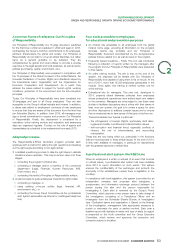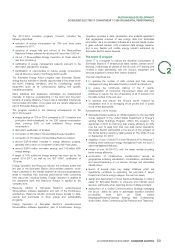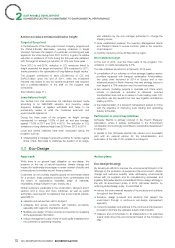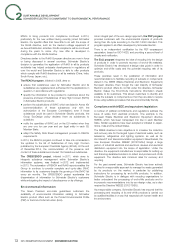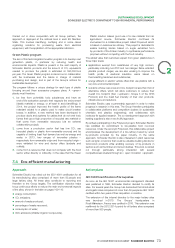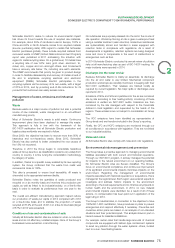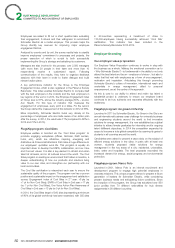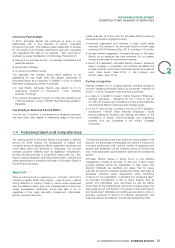APC 2014 Annual Report Download - page 75
Download and view the complete annual report
Please find page 75 of the 2014 APC annual report below. You can navigate through the pages in the report by either clicking on the pages listed below, or by using the keyword search tool below to find specific information within the annual report.
SUSTAINABLE DEVELOPMENT
SCHNEIDER ELECTRIC’S COMMITMENT TO ENVIRONMENTAL PERFORMANCE
Carried out in close cooperation with all Group partners, the
Plastic solution makes good use of a raw material from an
approach is deployed at the national level in each EU Member
agricultural source. Schneider Electric continues its
State. This involves identifying, certifying and in some cases
involvement in a collaborative project called Polywood which
organizing solutions for processing waste from electrical
is based on cellulose bio refinery. This project is dedicated to
equipment, with the application of the appropriate indicators.
enable building blocks based on sugar extracted from
by-products of the timber industry to synthesize performance
Green Plastic program polymers without competing with the food industry.
The added value that customers expect from green plastics lies in
The aim of this technological innovation program is to develop next three major areas:
generation plastic, in particular by reducing health and
environmental impacts. Plastic is present in the vast majority of applications exempt from substances of very high concern,
l
2
Schneider Electric products and the amount of CO2 equivalents particularly including non-PVC and non-halogen flame retardant
needed to produce the plastic is estimated at 550,000tons plastics product ranges; we are also working to improve the
peryear. The Green Plastic program is carried out in collaboration health profile of electrical insulation resins based on
with the businesses and the teams in charge of material thermosetting hardeners and substances;
purchasing and design, and is part of the Group’s actions for energy efficient or electric vehicle offers that use plastics with a
l
sustainable development. very low environmental impact;
The program follows a unique strategy for each type of plastic solutions whose resources and CO2 footprint is less than that of
l
focusing around three successive progress plans. A «green» alternative offers, which will allow customers to reduce their
plastic must therefore: overall CO2 footprint (their «upstream» Scope 3 of the GHG
Protocol) and the fossil fuel intensity of their own products,
be free from potentially toxic substances and have an1.
infrastructure and solutions.
end-of-life evaluation scenario that respects the environment
(ideally material or energy, or at least to avoid landfilling); in
Schneider Electric uses a partnership approach in order to make
2014, the project improved the health profile of the flame
progress in research in this area. The Group therefore participates
retardant added to a plastic used to make circuit breaker
in collaborative platforms and competitive clusters (in sustainable
boxes; in addition, a new method has been developed to
chemistry and plastics engineering), and collaborates with
produce ducts and systems for cables that do not emit toxic
institutes for applied research. The co-development approach with
fumes that use a high proportion of recycled raw material or
leading suppliers is also a very fruitful approach.
that come from renewable resources (via an external
By actively participating in the Polywood project, Schneider Electric
collaborative project);
has solidified its commitment to bio-plastics from non-food
come from a production sector that has low CO2 use2.
resources. Under the acronym Polywood, this collaborative project
(recycled plastic or plastic from renewable sources) and be
encompasses the development of a bio-refinery fueled by wood
capable of limiting fossil fuel demand as well as energy and
by-products provided by the paper industry. In the same
water; in 2013, two ranges of innovative plastics –
approach, Schneider Electric is also interested in plant resources
respectively from renewable origin and from recycled origin –
such as lignin or tannins that could be valuable building blocks for
were validated for wire and device offers (sockets and
tomorrow’s products while enabling recovery of by-products in
outlets);
sectors such as the timber and wine industries. This work is carried
out through particularly strong interaction with several
come from a resource that does not compete with the food3.
competitiveness clusters through an «open innovation» approach.
sector either directly or indirectly, in the case that the Green
Eco-efficient manufacturing
3.4
Approach Action plans
Schneider Electric has rolled out the ISO14001 certification for all
ISO14001 certification of Group sites
its manufacturing sites comprised of more than 50people and
large tertiary sites. All these sites contribute to reporting and As soon as the ISO14001 environmental management standard
therefore to the Group targets. The certification objective helps was published in1996, Schneider Electric decided to certify its
focus continuous efforts to reduce the main environmental impacts sites. For several years the Group has demanded that all industrial
of the sites, shown in the table on pages109-110: and logistic sites comprised of more than 50people be ISO14001
certified within two years of their acquisition or creation.
energy consumption;
l
The extension of this internal directive to the major tertiary sites
CO2emissions;
l
was launched in2010. The Groups’ headquarters in
amount of waste produced;
l
Rueil-Malmaison, France was certified in2010. This extension was
percentage of waste recovered;
l
reaffirmed for the 2012-2014 period for all tertiary sites comprised
consumption of water;
l
of more than 500people.
VOC emissions (Volatile Organic Compounds).
l
73
2014 REGISTRATION DOCUMENT SCHNEIDER ELECTRIC


